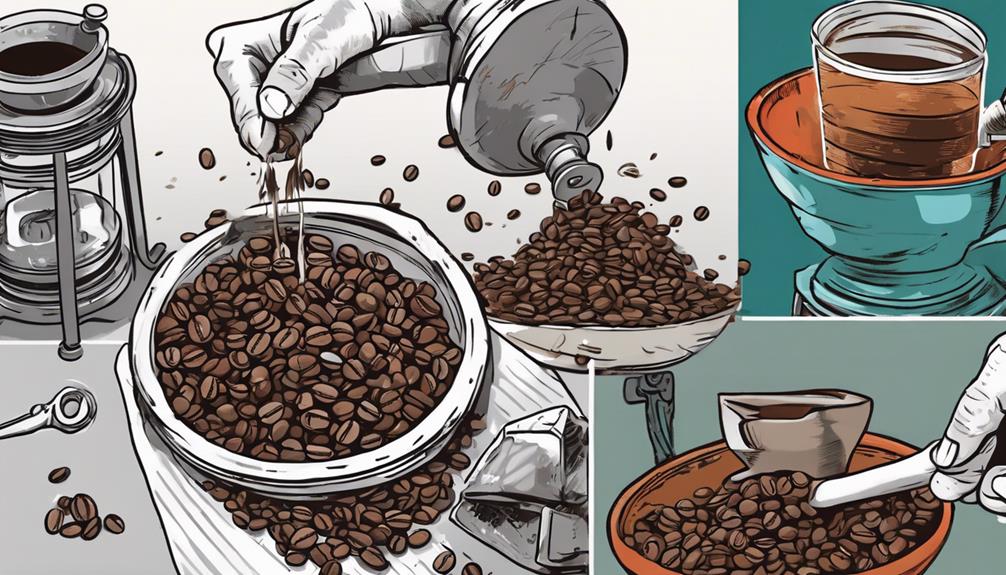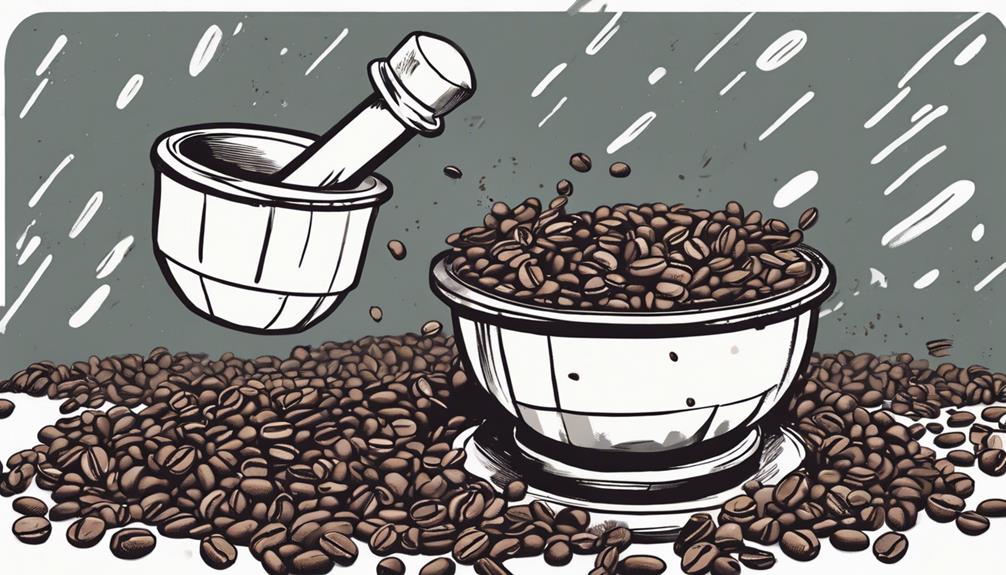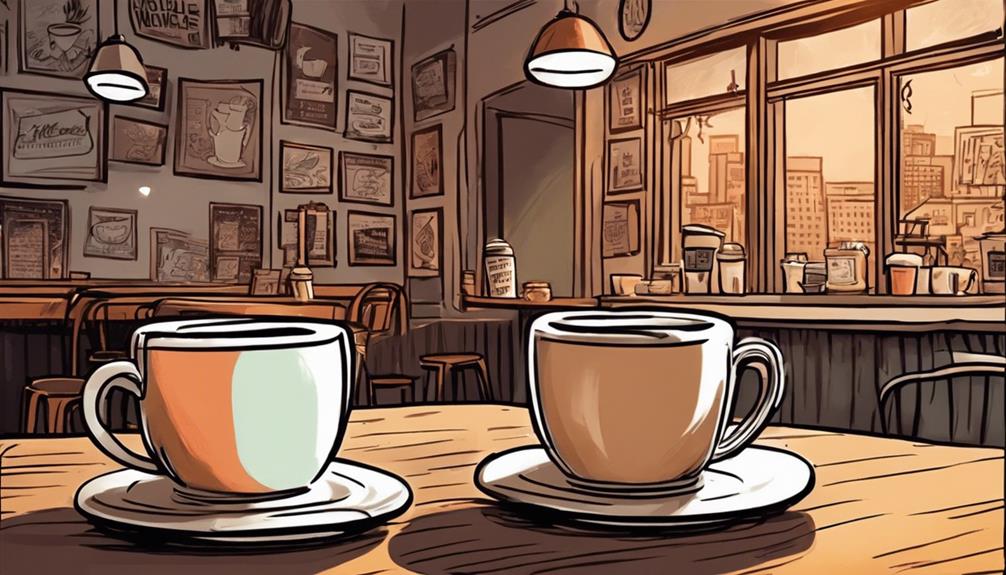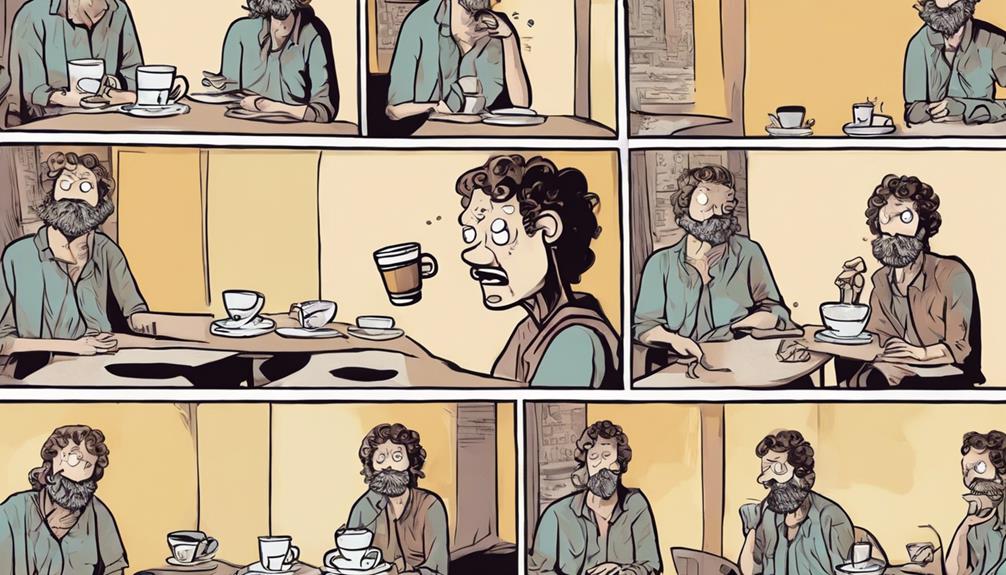You can grind coffee beans without a grinder! Experiment with a blender for a consistent grind, a food processor for larger batches, or crush beans in a bag with a rolling pin. Consider using a mortar and pestle for precision or a hammer for French press. Adjust the coarseness based on your preferred brewing method. These do-it-yourself techniques can enhance your coffee experience.
Key Takeaways
- Use a hammer or rolling pin for coarse grinding.
- Utilize a mortar and pestle for precision grinding.
- Try a food processor for larger batches.
- Adjust blending time in a high-speed blender.
- Break beans by hand for manual grinding.
Blender Grinding Method
For grinding coffee beans without a grinder, consider using a high-speed blender for a quick and effective method. To achieve a consistent grind, pulse the blender in short bursts. This method allows you to control the coarseness of the coffee grounds by adjusting the blending time.
However, be mindful of heat buildup in the beans as blending generates friction. Investing in a high-speed blender with a grind setting can provide better control over the grinding process. The pulse setting on the blender is particularly useful for this task as it allows you to grind the beans evenly without overheating them.
Experiment with different blending times to find the perfect coarseness for your preferred brewing method. By using a high-speed blender with the right settings and technique, you can enjoy freshly ground coffee at home without the need for a traditional grinder.
Food Processor Technique

Consider utilizing a food processor as an alternative method for grinding coffee beans without a grinder. When using a food processor, pulse the beans for about 15 seconds to achieve the desired grind size. Be sure to scrape down the sides of the food processor to guarantee even grinding of the beans. Food processors are capable of handling larger batches of beans compared to blenders, making them ideal when preparing coffee for a group.
| Food Processor Technique | |
|---|---|
| Equipment Needed | Food Processor |
| Steps | 1. Add coffee beans to the food processor. |
| 2. Pulse the beans for about 15 seconds. | |
| 3. Scrape down the sides for uniform grinding. | |
| 4. Repeat until desired grind size is achieved. |
Rolling Pin Process

To grind coffee beans without a grinder, try the Rolling Pin Process by placing the beans in a sealed plastic bag and using even pressure with a rolling pin for consistent grinding. This method allows you to crush the beans effectively, producing coarse grounds perfect for French press coffee.
Here's how to make the most of this technique:
- Apply even pressure: Maintain consistent grinding by exerting uniform pressure on the rolling pin.
- Adjust the pressure: Control the coarseness of your coffee grounds by varying the force applied to the rolling pin.
- Shake the bag: Periodically give the bag a good shake to ensure all beans are equally crushed, resulting in a uniform grind that suits your desired brewing methods.
The rolling pin method offers a simple and efficient way to break down coffee beans without a grinder, giving you the freedom to customize your grind for a delicious cup of French press coffee.
Mortar and Pestle Grinding

Try using a mortar and pestle for grinding coffee beans by filling the mortar with beans and crushing them with the pestle to control the grind size. This method allows you to grind your beans without the need for a grinder, providing a traditional and hands-on approach to achieving the desired consistency.
By pounding the beans in a circular motion, you can achieve a finer grind suitable for drip coffee, while adjusting the coarseness of the grounds to your liking. While this method may require manual effort, it offers precision in obtaining the perfect medium or coarse grind for your brew.
Simply start by placing the beans into the mortar, then use the pestle to crush them until the desired consistency is achieved. Mortar and pestle grinding may be laborious, but it's an effective way to produce flavorful coffee grounds for a delicious cup of joe.
Hammer Grinding Method

When hammer grinding coffee beans, your strength determines the coarseness of the grounds.
This method efficiently crushes beans, producing coarse grounds perfect for French press or cold brew.
Make sure to hammer on a stable surface to avoid accidents and spills.
Hammer Strength for Grinding
For grinding coffee beans using the hammer method, it is important to have a sturdy bag to securely contain the beans. Adjust the pressure of the hammer taps to control the coarseness of the grind, which is ideal for French press or cold brew. This method can be a quick and efficient way to grind coffee beans without a grinder.
Remember to ensure a stable surface for hammering to prevent any damage to your surroundings or equipment.
- Use a sturdy bag to securely contain the coffee beans.
- Adjust the pressure of the hammer taps for desired coarseness.
- Ideal for creating coarse grounds suitable for French press or cold brew.
Efficient Bean Crushing
Utilize the efficient bean crushing technique with a sturdy bag and hammer for quick and coarse coffee grounds suitable for French press or cold brew.
When aiming to grind coffee beans without a grinder, the hammer method offers a straightforward solution. Place the desired amount of coffee beans in a durable bag, ensuring it can withstand the impact of the hammer. Adjust the force of your strikes based on the desired coarseness of the grounds. Remember, a stable surface is essential to prevent any damage while hammering the beans.
This method provides an efficient way to crush coffee beans without the need for specialized equipment. The resulting coarse grounds are perfect for brewing methods like French press or cold brew, where a coarser grind is preferred.
Embrace this quick and effective approach for obtaining freshly ground coffee at home without a grinder.
Coffee Grinding Ratios

When it comes to grinding coffee beans, getting the ratios right is key.
You'll want to ponder the amount of coffee to water for the perfect brew strength.
Understanding the importance of grind size and how it impacts your brewing method can make a significant difference in the final taste of your coffee.
Ratios for Coffee Grinding
Enhance your coffee brewing experience by mastering the art of coffee grinding ratios. To achieve the perfect cup of coffee, understanding the ratios for coffee grinding is essential.
Here are some key tips to help you get started:
- Use the recommended coffee grinding ratio of 2 tablespoons of beans per 6 ounces of water as a starting point for a well-balanced brew.
- Adjust the ratio according to your taste preferences; increase the amount of coffee for a stronger flavor or decrease it for a milder taste.
- Experiment with different grinder settings and grind sizes to match the type of coffee you're brewing, whether it's for a French press, espresso, or another brewing method.
Importance of Grind Size
Selecting the appropriate grind size for your coffee beans plays an important role in determining the flavor and strength of your brewed coffee. The grind size directly impacts the extraction process, influencing how much flavor is extracted from the beans.
Different brewing methods, such as espresso and French press coffee, require specific grind sizes to achieve best results. For espresso, a finer grind is recommended to guarantee a rich and concentrated flavor, while a coarser grind is more suitable for French press coffee to prevent over-extraction and bitterness.
Maintaining the correct coffee grinding ratio is vital for achieving a balanced and flavorful cup of coffee. A commonly recommended ratio is 2 tablespoons of coffee beans per 6 ounces of water.
Adjusting the grind size according to your preferred brewing method and taste preferences can greatly enhance the taste and aroma of your coffee. Experimenting with different grind sizes allows you to fine-tune your brewing process and customize your coffee experience to perfection.
Brewing With Ground Beans
To brew with ground beans effectively, maintain the recommended coffee grinding ratio of 2 tablespoons of beans per 6 ounces of water. Adjust this ratio according to your taste preferences for a stronger or milder cup of coffee.
Remember, the coarseness of the grind impacts the strength and flavor of your brew. Experiment with different grind sizes based on your brewing method – whether it's a French press or espresso machine. Consistent grind size is essential for a balanced extraction and best flavor in your coffee.
When grinding the coffee beans, ensure a uniform coarseness to enhance the brewing process. After grinding the beans to the desired consistency, proceed by pouring boiling water over the grounds in your coffee maker to extract the flavors effectively.
Enjoy your freshly brewed cup of coffee made with care and attention to detail!
Grinding Coarseness Levels

Achieving the right coarseness level for your coffee grind is vital in determining the flavor profile of your brew.
When grinding the beans, consider that coarser grounds are ideal for French press coffee, providing a fuller-bodied taste.
On the other hand, finer grounds are necessary for espresso machines to extract bold flavors efficiently.
It's important to adjust the coarseness level based on your brewing method to achieve a well-balanced flavor in your cup.
Consistent grind size is key to ensuring even extraction and best taste in your final brew.
Experimenting with different grind sizes allows you to find the ideal balance for your preferred coffee brewing method, enhancing the overall coffee experience.
Grinding Without Electricity Tips

When faced with a situation where electricity is unavailable, consider utilizing manual grinding methods such as a rolling pin or mortar and pestle to break down coffee beans for your brew.
If you find yourself in need of grinding without electricity, here are some practical tips:
- Crushing Beans with a Hammer: Use a hammer to crush the beans for a coarse grind suitable for French press coffee.
- Grinding by Hand: While labor-intensive, grinding by hand can be an effective method to create coffee grounds.
- Breaking Beans in a Sealed Bag: Place the beans in a sealed bag and use a heavy object to crush them, offering a straightforward way to grind without a grinder.
These manual grinding techniques aren't only useful for situations without electricity but also perfect for camping or when you prefer a hands-on DIY approach to coffee grinding.
Benefits of Grinding Your Own Beans

Grinding your own beans enhances the freshness and flavor of your coffee greatly. Using a blender to grind coffee allows you to enjoy the full potential of the beans, ensuring a richer and more aromatic cup.
By grinding small batches of beans at a time, you can maintain their freshness and prevent them from losing their flavor over time. Unlike store-bought pre-ground coffee, freshly ground beans have a longer shelf life, preserving their taste and aroma for a more extended period.
Another benefit is the ability to adjust the grind coarseness to suit different brewing methods and your personal taste preferences. This flexibility allows you to experiment with various coffee flavors and brewing techniques, expanding your palate and enhancing your coffee experience.
Additionally, grinding your own beans can be a cost-effective option in the long run, saving you money while indulging in high-quality, freshly ground coffee.
Frequently Asked Questions
How to Break up Coffee Beans Without a Grinder?
To break up coffee beans without a grinder, grab a heavy object like a pan or hammer to smash beans in a sealed bag for a coarse grind. You can also use a rolling pin for controlled grinding. If you’re looking for a finer grind, you can try using a mortar and pestle, or even a food processor if you have one available. Alternatively, if you’re open to blending coffee beans by hand, you can try rubbing the beans between your palms or using a knife to finely chop them. Whichever method you choose, just make sure to keep a careful eye on the consistency to achieve the desired grind for your coffee.
How to Grind Coffee Beans by Hand?
To grind coffee beans by hand, you can use a mortar and pestle or a rolling pin in a sealed bag. It might feel like climbing a mountain with a toothpick, but the result is worth the effort for a fresh brew.
Can You Grind Coffee Beans With a Hand Blender?
Yes, you can grind coffee beans with a hand blender. Use the pulse setting for short bursts to achieve a consistent grind. Be mindful of heat generation to preserve the coffee's flavor. A hand blender offers versatility for different grind sizes.
How to Grind Coffee Beans With a Rolling Pin?
You can easily grind coffee beans with a rolling pin. Place the beans in a sealed bag, then roll the pin over it with even pressure. Adjust the grind size by varying pressure. Enjoy your freshly ground coffee!
Conclusion
To wrap up, breaking coffee beans without a grinder is a straightforward and gratifying process that enables you to tailor your coffee grounds to your liking. Whether you opt for a blender, food processor, rolling pin, mortar and pestle, or even a hammer, the outcome is a freshly brewed and delicious cup of coffee that you can savor each morning.
So, why not experiment with DIY grinding and enhance your coffee enjoyment starting now?









